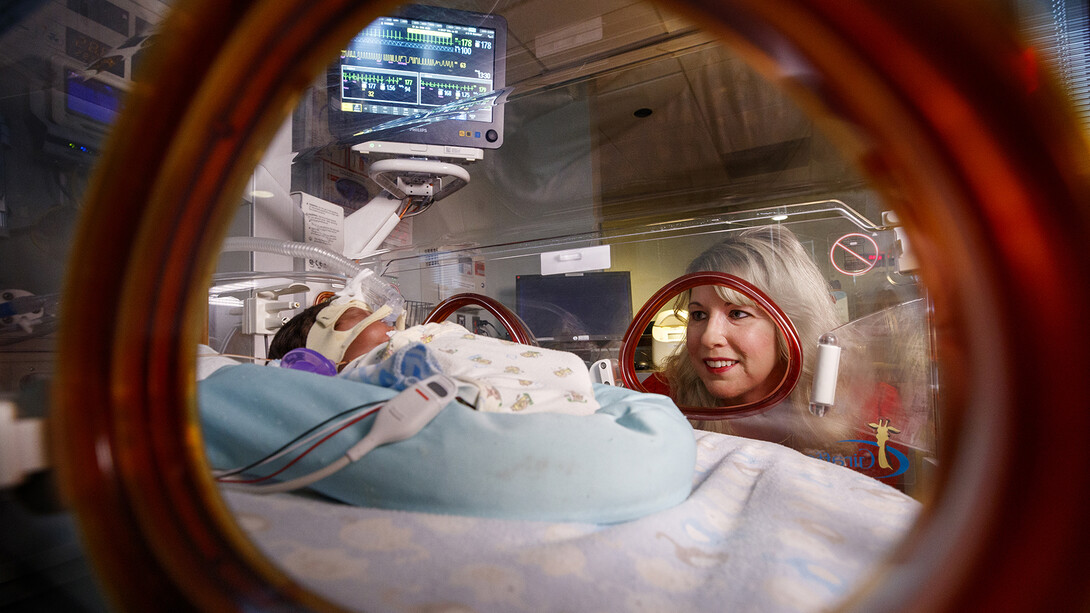
Nebraska Engineering research that shows quieter environments in neonatal intensive care units may result in better health outcomes for infants has been creating quite an unexpected buzz.
Erica Ryherd, associate professor of architectural engineering, and her co-authors were preparing to present the research at the biannual Acoustical Society of America conference in Louisville, Kentucky, in early May when media from around the world discovered the information that was prepared for the conference.
“It’s a topic that comes up periodically in the popular media, but this is the first time one of our group’s conference abstracts has blown up,” Ryherd said.
The project — which is headed by Ryherd and includes recent Nebraska architectural engineering doctorate recipient Jonathan Weber — is part of a larger body of studies by Ryherd’s research group looking into engineering solutions to acoustical issues in hospitals in hopes of creating healthier environments. Ashley Darcy-Mahoney, associate professor of nursing and director of the Infant Research, Autism and Neurodevelopmental Disorders Institute at George Washington University, is also on the research team, along with nurses and administrators at the study hospitals.
Ryherd’s research projects are among those that have generally showed benefits of reduced noise levels in hospitals, but Ryherd said there was little information about how quiet time specifically is affecting some of the most vulnerable patients — those infants in NICUs, and particularly over long periods of time. The decision to focus on NICUs was inspired by the nurses who work in those units.
“The quiet time was a staff-led initiative,” Ryherd said. “It was the staff in the NICUs that reached out to us because they were concerned and wanted to do something to improve the situations. We came on to help them refine it, assess it and provide some recommendations.”
Quiet-time protocols, which have been implemented in many NICUs, call for scheduled periods of quiet and/or softened sounds through behavioral and operational changes. Ryherd’s group helped to implement quiet times in three hospitals and assessed the results from before, shortly after and long-term (approximately 16 months) after quiet times were put in place. The group also studied physiological and records data about newborns in one of the hospitals to understand how quiet time impacted infant health.

For this study, the NICUs followed a structured protocol that had set hours and cues — such as lights dimming or a lullaby playing over speakers — to let people know the quiet time was beginning. Any activities, such as housecleaning, that were not considered urgent were scheduled at other times.
The results, Ryherd said, came through loud and clear. Some of the data provided surprises.
“The newborns seemed to thrive more during those quiet times, hopefully making it easier for premature babies to transition to life outside the womb and lowering the risk of disease,” Ryherd said. “But it wasn’t necessarily because of overall loudness, which was not changing as much as we hoped.”
Improvements, Ryherd said, came from three more detailed areas:
- Loud sounds were still occurring, but much less frequently.
- More time was spent at quieter levels and those periods were longer and more frequent.
- The pitch (acoustical frequencies) of speech, alarms and certain other ambient sounds was reduced.
“We would have missed all that if we had looked only at overall loudness,” Ryherd said. “We would have perhaps thought there wasn’t a whole lot happening here.”
The quiet-time protocols are only part of an overall recommendation. These would also include engineering solutions such as “thinking about how the units are designed, including the unit layout, the materials used in the building, the HVAC systems and overall noise control.”
These results also hit close to home for Ryherd, who was pregnant during the project.
“I was keenly interested in this research because this was an environment that I knew I could potentially be spending time in,” Ryherd said. “Being a patient or the parent of a patient (in a NICU) can be traumatic. In those situations, we don’t need noise making things even worse.”
After the births of her two daughters, Ryherd said she found herself implementing some of those findings at home, even if it was subconsciously.
“I’ve always been really aware of sounds for them and been cognizant of keeping things quiet and calm when it’s bedtime,” Ryherd said. “I am a mom, but I’m also an acoustical engineer, and there’s some of what I do for a living going on in the back of my brain at those times.”
Ryherd, who studied environmental medicine as a postdoctoral research fellow at Sweden’s Gothenburg University, said her interest in improving hospital acoustical environments is far from complete. Implementing quiet-time protocols in other areas could be part of that research.
“We plan to continue on with NICUs, but the whole idea of how quiet time and other soundscape interventions work in healing environments is interesting, whether it’s hospitals or other places,” Ryherd said.







